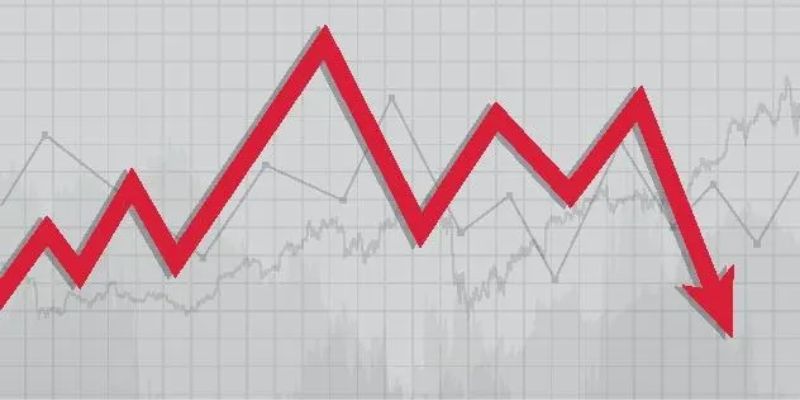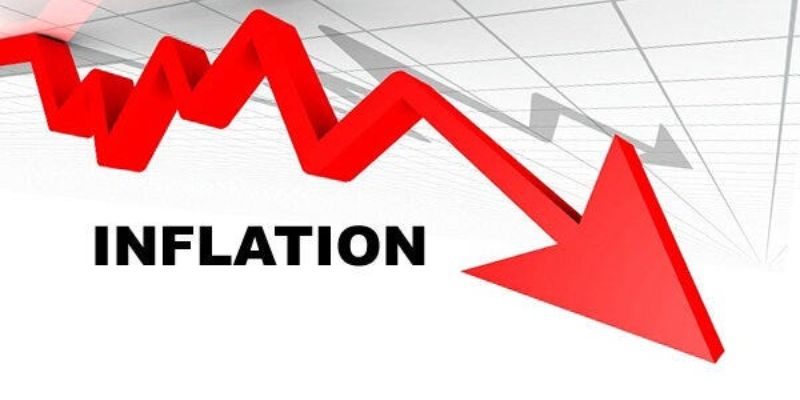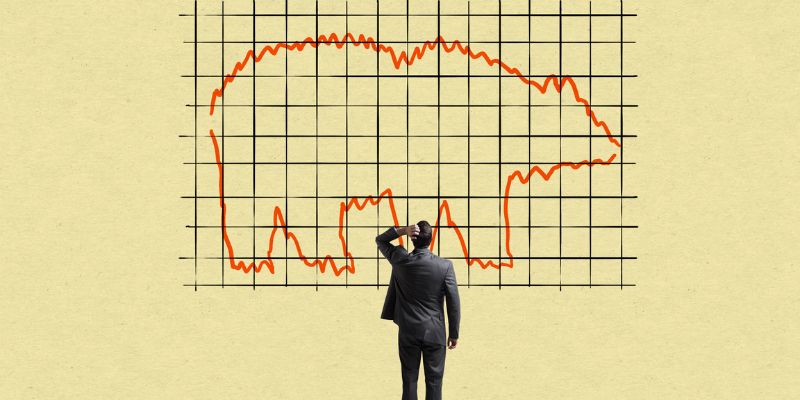Is there a stock market crash coming? Many folks whisper that question, scanning headlines for hints. But I don’t rely on whispers—I zero in on cold, hard facts. Look at the patterns; they often spill the secrets. Let’s break it down together: what the stock market’s vibe means, why our wallets feel different, and if now’s the time to buckle up for a bumpy ride. This isn’t just talk; I’ll guide you through the warnings tucked away in the numbers and news. It’s all about staying one step ahead. So, eyes open—let’s unveil what might lie ahead for the market, and more importantly, for you.
Understanding the Signals: Are We Heading Towards a Market Crash?
Deciphering Stock Market Indicators
Stock market gurus often hint at a crash. But what are the signs? Stocks can soar and plunge, raising fears. Yet the key lies in indicators. We look at stock prices, trading volumes, and company earnings. These tell us if stocks cost too much or expected profits fall short. High prices with low earnings spell trouble. It’s like a warning light flashing, urging caution. This is when you’ll hear the term “overvalued.” Overvalued means stocks cost more than they’re worth. It’s a classic sign that a drop might be near.
Alongside valuation concerns, we watch volumes. Trading volumes shoot up when many people buy or sell stocks. This can signal a shift. High volumes with falling prices can mean a selloff might kick off. It’s important for savers to know this. You don’t want to be last to sell when prices fall!
Examining Economic Warning Signs
Looking beyond stocks, economic warnings also catch our eye. We track signals like how much stuff companies make (GDP growth rate), people not having jobs (unemployment rates), and how much things cost (inflation trends). If fewer goods get made, or more people lose jobs, fear can grow. Folks might spend less. Businesses might cut back too. Less spending can hurt the economy, driving us to a downturn.
Consumer mood checks (consumer confidence) are also vital. When folks feel good, they spend more. This helps companies and the economy. But when people worry, they keep money in their pockets. This pinch on spending can lead to a crash. As we dig into these signs, we ask: Are they pointing to a bear market? That’s when stock prices keep sinking for a while. It shows investors are scared or unsure.
Also, we can’t ignore big world events. Trade wars or fights between countries (geopolitical tensions) sway stock markets. Plus, oil costs can shift quickly. A big jump might raise costs for companies, hurting profits. In turn, this can drive stock prices down.
Watch for these signs, they whisper tales of what might come. So, stay sharp and ready. Markets are fickle friends, but with a careful eye, you won’t be caught off guard.

Analyzing the Current Financial Landscape
Investigating the Recession Likelihood
Can we tell if a recession is near? There are clear signs. To figure this out, I keep an eye on several key factors. They range from job numbers to big buys and sells in the market.
How jobs numbers move is major. If fewer people have work, they spend less cash. This can push us towards a downturn. I look at how much stuff costs too. If prices jump a lot, it’s often a hint that a recession might be on the way. It’s not just one thing though. I dig into heaps of different data to guess what might happen next in our economy.
Another part is how well companies are doing. If they’re in a lot of debt, that’s a red flag. Money issues at big firms can ripple out and hurt the whole economy. I also watch how people feel about spending. Confident shoppers tend to buy more, giving the economy a boost.
Scrutinizing Equity Market Volatility and Bear Market Signals
Stock markets can be like roller coasters—full of ups and downs. Highs and lows in stock prices can tell us a lot. These moves can warn us of a bear market, where stocks drop for a while. So, what shows us a bear market might come? One sign is if a lot of people are scared. That fear can spread and knock down prices.
Then, there’s “bull market end.” This happens when the good times in the market start to fade. If stock costs seem too high, that could mean they’ll fall soon. I also look at how often stocks swing from high to low prices. If it’s a lot, that can mean trouble is brewing.
I keep tabs on what investors think, too. If they’re nervous, they might sell, which can push prices down. Even global stuff, like tensions in other countries, can change what happens here. All these pieces matter when I’m checking out risks in the market.
Understanding the flow of cash in the market is key. When cash is tight, it can mean folks are worried. If banks are careful with lending, that’s another point for me to ponder. And when I see that more people are betting that stock prices will drop, I take note.
In my toolkit are some sharp ways to find hints about market turns. These include figuring out if lots of people are betting against the market. High numbers here can mean a crash or a correction (that’s a smaller drop) might be on the way.
As a pro, people ask me what to do with their cash to stay safe. I say, spread it out. Have different kinds of investments. And keep an eye on things with me. This way, we’re all set for what the market might toss our way.
Remember, these are just clues. No one can say for sure what will happen next. But by keeping a close watch, I try to be one step ahead. So, we can all be ready for any market shake-ups that might come our way.

Predicting the Future of Investments
The Role of Financial Bubble Speculation in Market Corrections
When bubbles burst, they scare us all. They are big, puffy things full of air that grow and grow until—pop!—they’re gone, just like that. In the stock market, some say a “financial bubble” is just like these playful bubbles. We pump money into stocks until prices are way too high. Then, one day, like a bubble, they can burst. The market falls fast. This drop is what we call a “market correction.”
Think about a time when lots of people wanted the same toy. The price went way up because everyone wanted one. But after a while, people saw that the toy was not worth all that money. Then, prices dropped. This is what can happen in the stock market too. When too many people buy stocks at high prices, but the companies aren’t really that good, a fall can come. It’s like that toy.
Now, you might wonder, how can we guess when this will happen? Well, it’s tough. We can look at how much the stocks cost compared to what the company earns. This is called “stock valuation.” If the price is a lot more than the earnings, watch out! That’s a sign.
Some smarty folks, like me, dig deep to see if a stock or the whole market is too puffed up. We look at past times when markets went up and then down fast. We learn from them. We look at signs in the economy, too, like if people are spending less money or if there are fewer jobs. These can tell us if the market might turn bad soon.
Historical Precedents and Market Downturn Predictions
Now, let’s hop into our time machine and look back. We’ve had some big market crashes before. Like the dot-com bubble. Back then, people got way too excited about new internet companies. They threw their money at these stocks. But many of these companies didn’t make much money. They were puffed up. Then—pop!—it all fell apart.
Or think about the 2008 mess. That one hurt. Houses cost too much. Banks gave loans, lots of them, to people who couldn’t pay back. The whole thing was a house of cards. When it fell, it brought down banks and the stock market too.
We use these stories from the past to help guess what might happen next. What we learn is like pieces of a puzzle. We put them together to see the big picture. Sometimes, this picture can show us if a market crash might come.
So, what’s the point of all this talk? It’s about being smart. Knowing when to be careful with your money. It’s not always easy to know, but the signs can help. We look at how things have gone in the past, and we look at what’s happening now. That way, we can make our best guess and be ready for whatever comes next, good or bad.

Strategic Planning for Potential Market Turbulence
Comprehensive Investment Risk Assessment
Let’s dive right into risk. In finance, risk is a big deal. Think of it like a game where you can win or lose money. As an expert, I keep my eyes on the signs that could spell trouble, like a big wave ahead for a surfer.
First, we look at things called stock market indicators. These are like weather tools, telling us what might happen with stocks. Sometimes they show a sunny sky; other times, a storm brews on the horizon.
Economic warning signs are next. They are the warning lights on a car’s dashboard. When these flash, we need to pay attention. A few major ones include how fast our economy grows (GDP growth rate), and if people have jobs (unemployment rates).
Now, I also study past troubles, like the dot-com bubble and the 2008 financial crash. These past crashes are like history lessons, showing us what can go wrong. We look for things that are the same today, or different, to see if another crash might come.
And it’s not just the past. I look at what’s happening all over the world, like trade wars or fights between countries (geopolitical tensions). These can shake up markets, just like a rough sea can rock a boat.
Proactive Measures: Market Liquidity, Credit Conditions, and Speculation Activity Analysis
Let’s talk about being proactive – that’s like putting on your seatbelt before driving. In the stock market, it means being ready before things get rough.
Market liquidity is like water in a pool. If there’s a lot of water (money), swimming (trading) is easy. But if the pool dries up, we might have a problem. We keep an eye on the cash flow to spot trouble.
Next up: credit market conditions. This is about how easy it is to borrow money. When it’s easy, people spend and invest more. But if it gets hard to borrow, it can mean a crash is coming.
Speculation activity, like short selling or put option volumes, is also key. This is like betting on which way stocks will go. Big bets on stocks falling can be a red flag.
I use all this info to think about how much investment risk you might face. I look for bear market signals – a bear market means stocks are falling. These signals tell us if stocks might drop more.
If you’d like to stay safe when a market gets wild, remember this: mix up your investments (portfolio diversification), and think about where you put your money (asset allocation plans). Like with any storm, being prepared is the best defense.
We’ve looked at signs that may point to a market crash, from tricky stock signals to big economy red flags. We poked around the current finance scene and talked about the chance of a recession. We’ve asked if stocks are too shaky and spotted bear market hints.
We also tried to guess what your cash should do next. Is a bubble about to pop? We checked past trends to see if they tell us anything. And finally, we talked smart moves to make just in case things go south. Are you ready to face risks head-on? Think about how solid your investments are. Look at cash flow, debts, and wild guesses in the market.
In the end, no one has a crystal ball to see the future. But with smart planning and a keen eye on these signs, you can aim to stay ahead, or at least not fall behind when things get rough. Keep these ideas in your pocket and you’ll be better at rolling with the punches if the market gets tough. Stay alert, stay informed, and keep those investments safe.
Q&A :
Is the Stock Market Expected to Crash Soon?
While it’s impossible to predict market movements with absolute certainty, financial analysts use various economic indicators and models to forecast potential downturns. Regular monitoring of stock market trends, investor sentiment, economic policies, and global events can provide insights. It’s always wise for investors to stay informed and consider professional financial advice tailored to their individual risk tolerance.
What Are the Warning Signs of a Stock Market Crash?
Several key indicators can signal a potential stock market crash, including a rapid increase in stock prices (creating a bubble), a high price-to-earnings (P/E) ratio across the market, extreme investor borrowing to purchase stocks (margin debt), and significant economic downturns. Investors should watch out for these signs and adjust their strategies accordingly to mitigate potential risks.
How Can I Protect My Portfolio from a Stock Market Crash?
Diversification is a fundamental strategy to protect your investment portfolio. This means spreading your investments across multiple assets, such as stocks, bonds, real estate, and commodities. Investors may also consider having a portion of their portfolio in defensive stocks that tend to be less volatile during economic downturns, establishing stop-loss orders, and maintaining a cash reserve.
Can Economic Policies Prevent a Stock Market Crash?
Governments and central banks can sometimes implement fiscal and monetary policies to stabilize the markets. Fiscal policies, such as adjusting tax rates or government spending, and monetary policies, like manipulating interest rates or quantitative easing, can influence economic growth and investor confidence. However, such measures may not always prevent a market crash and can sometimes delay inevitable corrections.
What Should I Do After a Stock Market Crash?
After a market crash, it’s essential to carefully assess your financial situation and investment goals. While some investors might see a crash as a buying opportunity, purchasing stocks at lower prices, others might need to reevaluate their risk tolerance and investment strategy. Seeking advice from financial professionals and not making decisions based on panic are key steps in navigating post-crash market conditions.

